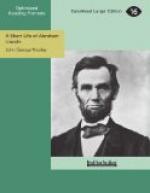After some delay, he found himself in Richmond, and was accorded a confidential interview by the rebel President on January 12, 1865, when he unfolded his project, which proved to be nothing less than a proposition that the Union and Confederate armies cease fighting each other and unite to drive the French from Mexico. He supported this daring idea in a paper of some length, pointing out that as slavery, the real cause of the war, was hopelessly doomed, nothing now remained to keep the two sections of the country apart except the possible intervention of foreign soldiery. Hence, all considerations pointed to the wisdom of dislodging the French invaders from American soil, and thus baffling “the designs of Napoleon to subject our Southern people to the ‘Latin race.’”
“He who expels the Bonaparte-Hapsburg dynasty from our southern flank,” the paper said further, “will ally his name with those of Washington and Jackson as a defender of the liberty of the country. If in delivering Mexico he should model its States in form and principle to adapt them to our Union, and add a new southern constellation to its benignant sky while rounding off our possessions on the continent at the Isthmus, ... he would complete the work of Jefferson, who first set one foot of our colossal government on the Pacific by a stride from the Gulf of Mexico....”
“I then said to him, ’There is my problem, Mr. Davis; do you think it possible to be solved?’ After consideration, he said: ‘I think so.’ I then said, ’You see that I make the great point of this matter that the war is no longer made for slavery, but monarchy. You know that if the war is kept up and the Union kept divided, armies must be kept afoot on both sides, and this state of things has never continued long without resulting in monarchy on one side or the other, and on both generally.’ He assented to this.”




